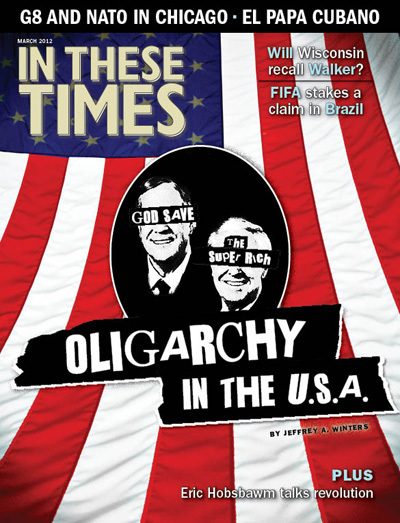Oligarchy in the U.S.A.
The wealth defense industry protects the richest of the rich.
Jeffrey A. Winters

In 2005, Citigroup offered its high net-worth clients in the United States a concise statement of the threats they and their money faced.
The report told them they were the leaders of a “plutonomy,” an economy driven by the spending of its ultra-rich citizens. “At the heart of plutonomy is income inequality,” which is made possible by “capitalist-friendly governments and tax regimes.”
The danger, according to Citigroup’s analysts, is that “personal taxation rates could rise – dividends, capital gains, and inheritance taxes would hurt the plutonomy.”
But the ultra-rich already knew that. In fact, even as America’s income distribution has skewed to favor the upper classes, the very richest have successfully managed to reduce their overall tax burden. Look no further than Republican presidential contender Mitt Romney, who in 2010 paid 13.9 percent of his $21.6 million income in taxes that year, the same tax rate as an individual who earned a mere $8,500 to $34,500.
How is that possible? How can a country make so much progress toward equality on other fronts – race, gender, sexual orientation and disability – but run the opposite way in its policy on taxing the rich?
In 2004, the American Political Science Association (APSA) tried to answer that very question. The explanation they came up with viewed the problem as a classic case of democratic participation: While the poor have overwhelming numbers, the wealthy have higher rates of political participation, more advanced skills and greater access to resources and information. In short, APSA said, the wealthy use their social capital to offset their minority status at the ballot box.
But this explanation has one major flaw. Regardless of the Occupy movement’s rhetoric, most of the growth in the wealth gap has actually gone to a tiny sliver of the 1% – one-tenth of it, or even one-one-hundredth.
Even more shockingly, that 1 percent of the 1% has shifted its tax burden not to the middle class or poor, but to rich households in the 85th to 99th percentile range. In 2007, the effective income tax rate for the richest 400 Americans was below 17 percent, while the “mass affluent” 1% paid nearly 24 percent. Disparities in Social Security taxes were even greater, with the merely rich paying 12.4 percent of their income, while the super-rich paid only one-one-thousandth of a percent.
It’s one thing for the poor to lose the democratic participation game, but APSA has no explanation for why the majority of the upper class – which has no shortage of government-influencing social capital – should fall so far behind the very top earners. (Of course, relative to middle- and lower-class earners, they’ve done just fine.)
For a better explanation, we need to look more closely at the relationship between wealth and political power. I propose an updated theory of “oligarchy,” the same lens developed by Plato and Aristotle when they studied the same problem in their own times.
A quick review
First, let’s review what we think we know about power in America.
We begin with a theory of “democratic pluralism,” which posits that democracy is basically a tug-of-war with different interest groups trying to pull government policy toward an outcome. In this framework, the rich are just one group among many competing “special interests.”
Of course, it’s hard not to notice that some groups can tug better than others. So in the 1950s, social scientists, like C. Wright Mills, author of The Power Elite, developed another theory of “elites” – those who wield more pull thanks to factors like education, social networks and ethnicity. In this view, wealth is just one of many factors that might help someone become the leader of a major business or gain a government position, thereby joining the elite.
But neither theory explains how the super-rich are turning public policy to their benefit even at the expense of the moderately rich. The mass affluent vastly outnumber the super-rich, and the super-rich aren’t necessarily better-educated, more skilled or more able to participate in politics; nor do the super-rich dominate the top posts of American government – our representatives tend to be among the slightly lower rungs of the upper class who are losing the tax battle.
Also, neither theory takes into account the unique power that comes with enormous wealth – the kind found in that one-tenth of the 1%. Whether or not the super-rich hold any official position in business or government, they remain powerful.
Only when we separate wealth from all other kinds of power can we begin to understand why our tax system looks the way it does – and, by extension, how the top one-tenth of 1% of the income distribution has distorted American democracy.
Enormous wealth is the heart of oligarchy.
So what’s an oligarchy?
Across all political spectrums, oligarchs are people (never corporations or other organizations) who command massive concentrations of material resources (that is, wealth) that can be deployed to defend or enhance their own property and interests, even if they don’t own those resources personally. Without this massive concentration of wealth, there are no oligarchs.
In any society, of course, an extremely unequal wealth distribution provokes conflict. Oligarchy is the politics of the defense of this wealth, propagated by the richest members of society.
Wealth defense can take many forms. In ancient Greece and Rome, the wealthiest citizens cooperated to run institutionalized states that defended their property rights. In Suharto’s Indonesia, a single oligarch led a despotic regime that mostly used state power to support other oligarchs. In medieval Europe, the rich built castles and raised private armies to defend themselves against each other and deter peasants tempted by their masters’ vaults. In all of these cases oligarchs are directly engaged in rule. They literally embody the law and play an active role in coercion as part of their wealth defense strategy.
Contemporary America (along with other capitalist states) instead houses a kind of “civil oligarchy.” The big difference is that property rights are now guaranteed by the impersonal laws of an armed state. Even oligarchs, who can be disarmed for the first time in history and no longer need to rule directly, must submit to the rule of law for this modern “civil” arrangement to work. When oligarchs do enter government, it is more for vanity than to rule as or for oligarchs. Good examples are New York City Mayor Michael Bloomberg, former presidential candidate Ross Perot and former Massachusetts Governor Mitt Romney.
Another feature of American oligarchy is that it allows oligarchs to hire skilled professionals, middle- and upper-class worker bees, to labor year-round as salaried, full-time political advocates and defenders of the oligarchy. Unlike those backing ordinary politicians, the oligarchs’ professional forces require no ideological invigoration to keep going. In other words, they function as a very well-paid mercenary army.
Whatever views and interests may divide the very rich, they are united in being materially focused and materially empowered. The social and political tensions associated with extreme wealth bond oligarchs together even if they never meet, and sets in motion the complex dynamics of wealth defense. Oligarchs do overlap with each other in certain social circles that theorists of the elite worked hard to map. But such networks are not vital to their power and effectiveness. Oligarchic theory requires no conspiracies or backroom deals. It is the minions oligarchs hire who provide structure and continuity to America’s civil oligarchy.
The U.S. Wealth Defense Industry
The threats to wealth that oligarchs face, and want to overcome, create the enormous profit-making opportunities that motivate the wealth defense industry, or WDI. In American oligarchy, it consists of two components.
The first is the mercenary army of professionals – lawyers, accountants, wealth management agencies – who use highly specialized knowledge to navigate 72,000 pages of tax code and generate a range of tax “products” and advice, enabling oligarchs to collectively save scores of billions of dollars, every year, that would otherwise have to be surrendered to the state. While most of us are what I call “TurboTaxpayers,” buying cheap tax software to navigate our returns and make routine deductions, oligarchs purchase complex “tax opinion letters” from professional firms. These letters are drafted to justify enormous nonpayments of taxes if the IRS ever questions how certain transactions produce losses, or how other accounting gymnastics make it appear that no gains or compensation occurred. The letters can cost up to $3 million each, but can save an oligarch tens or hundreds of millions of dollars in a given year.
Written by some of the most high-powered attorneys and firms in the industry, tax letters serve to intimidate the legal department of the IRS even before a prosecution is contemplated.
The Senate is aware of these letters – noting in a 2003 report on the “tax shelter industry” that “respected professional firms are spending substantial resources … to design, market, and implement hundreds of complex tax shelters, some of which are illegal and improperly deny the U.S. Treasury of billions of dollars in tax revenues” – but getting specific information about them is extremely difficult, since the IRS rarely prosecutes oligarchs. When it does, most cases are sealed, and oligarchs who work with tax attorneys can invoke attorney-client privilege. But in 2003, there was a breach of this fortress of secrecy when the Senate published detailed reports about illegal tax shelters created by the accounting firm KPMG.
According to the Senate, the KPMG tax shelters created “phony paper losses for taxpayers, using a series of complex, orchestrated transactions involving shell corporations, structured finance, purported multi-million dollar loans, and deliberately obscure investments” for 350 clients between 1997 and 2001. The fake losses totaled about $8.4 billion, or $24 million per client; applied against their incomes, these losses reduced the taxes of each oligarch by an average of $8.3 million, or $2.9 billion for the group.
One of the reasons this case was exposed is that it was all rather down-market, using cheap cookie-cutter tax opinion letters priced at a mere $350,000 each.
Not only did all the firms and banks conspiring on behalf of these 350 oligarchs – and the oligarchs themselves – know that the investments “had no reasonable potential for profit,” but KPMG calculated that even if it was fined for failing to disclose the shelters, it would still earn far more in fees than it would pay in fines. The firm was fined $456 million. Even more incredibly, more than a dozen KPMG clients sued the firm for the taxes and penalties incurred after being discovered – the suits claim that KPMG bungled its job of creating shelters for tax evasion with zero legal risks for oligarchs. It’s tantamount to suing your hit man for a sloppy murder.
The second component of the WDI is the nitty-gritty legwork that keeps the tax system sufficiently porous, complex and uncertain enough to be manipulated. Some oligarchs do this work themselves, speed dialing public officials to directly complain about laws and regulations, but most do not. Instead, WDI professionals, motivated to earn a share of annual oligarchic gains, constitute a highly coherent and aggressive network for political pressure. These lobbyists fight to insert favorable material into the tax code, cut sections that cause problems, and block threats on the horizon.
Apologists for havens
Discussions about money in politics often begin with campaign finance reform. Advocates argue that a small fraction of wealthy Americans constitute a powerful donor class that provides the vast majority of candidates’ funds. Long before ordinary citizens get to vote, they say, their choices are reduced to politicians deemed acceptable by the richest Americans via a “wealth primary,” in which candidates straying from a narrow economic agenda are shut out of campaign funding.
“For all their influence at the polls, guys like Joe the Plumber aren’t typically campaign contributors,” explains Sheila Krumholz, executive director of the Center for Responsive Politics. “You’re more likely to see John the Bond Trader bankrolling these campaigns.” And she’s right: Of the roughly 1.4 million individual contributions of $200 or more during the 2008 elections, three-fourths of the money came from a mere one-fifth of the donors, who in turn comprised one-tenth of 1 percent of American adults.
But while this fraction does coincide with our approximation of the size of the American oligarchy, campaign donations are not oligarchs’ primary or even most effective strategy for political influence. Academics Michael Graetz and Ian Shapiro explain this in their 2005 book, Death by a Thousand Cuts: The Fight over Taxing Inherited Wealth.
“Campaign contributions, soft money, spending limits for political candidates and the like have become controversial issues,” they admit, “but they mattered little in the estate tax fight.” The battle was between smaller oligarchs and the biggest players at the top. Believing it unlikely that the elimination of the estate tax could be extended indefinitely, a significant number of wealthy Americans with a net worth between $5 and $15 million wanted the threshold moved up to exempt their estate tax. In exchange, they supported a higher estate tax rate on everyone above the threshold. Big oligarchs took the opposite position. They wanted no estate tax at all. But if Congress was going to bring it back, the ultra-rich supported a lower exemption in exchange for a lower overall rate.
The big oligarchs won again – but not because of campaign finance. “Money mattered more fundamentally in shifting the tectonic plates underlying American tax debates,” Graetz and Shapiro suggest. And this is precisely where oligarchs deploy their resources in the WDI.
Oligarchs’ “three decades of investments in activist, conservative think tanks” has blazed an ideological path that drones in the WDI follow. Activists at institutions like the Heritage Foundation supply “ideological ammunition to the lobbyists and interest groups … who work relentlessly … to keep up the tax-cutting pressure on the Hill.”
This pressure was hard at work in President Obama’s feeble attempt to curtail offshore tax havens in 2009. In the middle of massive public bailouts to the financial system and large bonuses on Wall Street, the president proposed stronger measures to fight against who he called “tax cheats,” the individuals using offshore tax havens to deny the government nearly $70 billion a year – a level equal to about seven cents on every dollar of taxes paid honestly.
But Obama’s proposals were less aggressive than his rhetoric. The president urged Congress to support efforts to sanction nations that maintained secrecy on bank accounts and corporate entities, and sought to hire 800 additional IRS agents “to detect and pursue American tax evaders abroad”; these measures were projected to save a mere $8.7 billion over 10 years – about one percent of the losses from offshore accounts. Despite the timidity, the proposals received only a lukewarm response from Democrats and outright hostility from Republicans, who argued that they would cripple American corporations’ ability to compete globally.
Dan Mitchell, a senior fellow (i.e. mercenary) at the Cato Institute (a think tank financed by American oligarchs), defended tax havens as “outposts of freedom.” If Americans are concerned that “individuals are moving their money to countries with better tax law, that should be a lesson to us that we should fix our tax law.”
In other words: Let’s decrease taxes on the super-rich.
The WDI, arising naturally from the opportunities and risks created by enormous wealth, has spawned its own pile of these opinion-makers, free to spread their ideas through a compliant corporate media while oligarchs themselves are free to look on.
Oligarchy, or Democracy?
To argue that the United States is a thriving oligarchy does not imply that our democracy is a sham: There are many policies about which oligarchs have no shared interests. Their influence in these areas is either small or mutually canceling.
Though it may strike at the heart of elitism, greater democratic participation is not an antidote to oligarchic power. It is merely a potential threat. Only when participation challenges material inequality – when extreme wealth is redistributed – do oligarchy and democracy finally clash.
The answer to the question of inequality, then, is troubling. Wars and revolutions have destroyed oligarchies by forcibly dispersing their wealth, but a democracy never has.
Democracy and the rule of law can, however, tame oligarchs.
A campaign to tame oligarchs is a struggle unlikely to fire the spirits of those outraged by the profound injustices between rich and poor. However, to those enduring the economic and political burdens of living among wild oligarchs, it is an achievement that can improve the absolute welfare of average citizens, even if the relative gap between them and oligarchs widens rather than narrows.
A graduate student in one of my seminars – resisting my terminology – once declared that the “U.S. has rich people, not oligarchs.” More than anything else, that statement claims that somehow American democracy has managed to do something no other political system in history ever has: strip the holders of extreme wealth of their inherent power resources and the political interests linked to protecting those fortunes.
Of course, this hasn’t happened.
But it is endlessly fascinating that we’re now in a moment when Americans are once again asking fundamental questions about how the oligarchic power of wealth distorts and outflanks the democratic power of participation.





